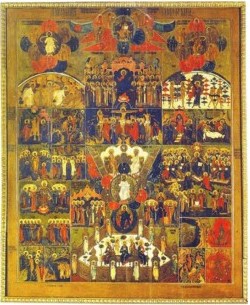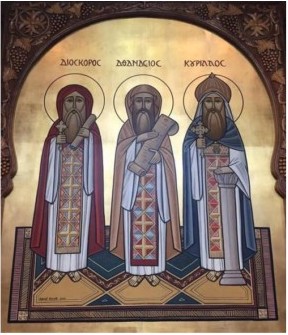0276 Manichaeism - Manichaeism teaches an elaborate dualistic cosmology describing the struggle between a good, spiritual world of light; and an evil, material world of darkness. Through an ongoing process that takes place in human history, light is gradually removed from the world of matter and returned to the world of light, whence it came. Its beliefs are rooted in Zoroastrian dualism preserved in gnostic religious movements. Manichaeism spreads with extraordinary speed both east and west. It reaches Rome through the apostle Psattiq by 280 CE, via Egypt, where it flourishes in the
Fayum area c. 290. Manichaean monasteries exist in Rome in 312 during the time of Pope Miltiades. In 296, Diocletian decrees against the Manichaeans: "We order that their organizers and leaders be subject to the final penalties and condemned to the fire with their abominable scriptures." This results in martyrdom for many in Egypt and North Africa. In 354, Hilary of Poitiers writes that the Manichaean faith is a significant force in southern Gaul. In 381, Christians request that Theodosius I strip Manichaeans of their civil rights. He issues a decree of death for Manichaean monks in 382.
 0300 Arianism - “Jesus was begotten by and is subordinate to the Father,” a belief held today by Jehovah’s Witnesses.
0325 The First Council of Nicaea is summoned to resolve a disagreements arising from within the Church of Alexandria over Arianism: whether the Son was 'begotten' by the Father from his own being, and therefore had no beginning, or else was created out of nothing, and therefore had a beginning. This hyper-intellectualization of Christianity allows total control over the message, and of course the loser of the debate, Arius, is banished.
0350 Donatism - Elements of the Church attack apostate clergy who had collaborated with the Roman persecutors as unworthy to administer sacraments. Augustine of Hippo campaigns against Donatism as bishop, and through his efforts, orthodoxy gains the upper hand. According to Augustine, sacramental validity is a property of the priesthood independent of the individual character of the priest. Influenced by the Old Testament, he believes in discipline as a means of education. In his letter to Vincentius, Augustine uses the New Testament Parable of the Great Banquet to justify using force against the Donatists: "You are of the opinion that no one should be compelled to follow righteousness; and yet you read that the householder said to his servants, 'Whomsoever ye shall find, compel them to come in.'" The Church thereafter conveniently uses Augustine's texts to justify the use of force in the persecution of pagan religions, of heretics by the Inquisition, and of Native American religions.
The early reformers John Wycliffe (d. 1384), who teaches that the moral corruption of priests invalidates their offices and sacraments, and Jan Hus (d. 1415), who argues that a prelate's moral character determines his ecclesiastical authority, are accused of Donatism and condemned as heretics at the Council of Constance (1414-8).
0367 Athenasius, bishop of Alexandria, determines the canonical Scriptures of New Testament; the Gnostic Nag Hamadi text of the Gospel of Thomas is hidden by Gnostics shortly thereafter.
0300 Arianism - “Jesus was begotten by and is subordinate to the Father,” a belief held today by Jehovah’s Witnesses.
0325 The First Council of Nicaea is summoned to resolve a disagreements arising from within the Church of Alexandria over Arianism: whether the Son was 'begotten' by the Father from his own being, and therefore had no beginning, or else was created out of nothing, and therefore had a beginning. This hyper-intellectualization of Christianity allows total control over the message, and of course the loser of the debate, Arius, is banished.
0350 Donatism - Elements of the Church attack apostate clergy who had collaborated with the Roman persecutors as unworthy to administer sacraments. Augustine of Hippo campaigns against Donatism as bishop, and through his efforts, orthodoxy gains the upper hand. According to Augustine, sacramental validity is a property of the priesthood independent of the individual character of the priest. Influenced by the Old Testament, he believes in discipline as a means of education. In his letter to Vincentius, Augustine uses the New Testament Parable of the Great Banquet to justify using force against the Donatists: "You are of the opinion that no one should be compelled to follow righteousness; and yet you read that the householder said to his servants, 'Whomsoever ye shall find, compel them to come in.'" The Church thereafter conveniently uses Augustine's texts to justify the use of force in the persecution of pagan religions, of heretics by the Inquisition, and of Native American religions.
The early reformers John Wycliffe (d. 1384), who teaches that the moral corruption of priests invalidates their offices and sacraments, and Jan Hus (d. 1415), who argues that a prelate's moral character determines his ecclesiastical authority, are accused of Donatism and condemned as heretics at the Council of Constance (1414-8).
0367 Athenasius, bishop of Alexandria, determines the canonical Scriptures of New Testament; the Gnostic Nag Hamadi text of the Gospel of Thomas is hidden by Gnostics shortly thereafter.

St. Dioscorus (left), Pope of Alexandria
0381 Monophysitism maintains that after the union of the divine and the human in the person of Jesus Christ, he had only a single "nature" which was divine. Monophysitism is contrasted to duophysitism, which maintains that Christ maintained two natures, one divine and one human after incarnation. Monophysitism is born in the theological "School of Alexandria," which begins its Christological analysis with the (divine) eternal Son or Word of God and seeks to explain how this eternal Word became incarnate as a man — in contrast to the "School of Antioch" (birthplace of Nestorianism, the antithesis of Monophysitism), which instead begins with the (human) Jesus of the Gospels and seeks to explain how this man became united with the eternal Word in the Incarnation. Accepted by the Sees of Rome, Constantinople, and Antioch, the Chalcedonian settlement (451CE) encounters strong resistance in Alexandria (and in Egypt generally), leading ultimately to the schism between the Oriental Orthodox churches (which reject Chalcedon) on the one hand, and the so-called Chalcedonian churches on the other. There are two major doctrines that can indisputably be called "monophysite":
(1) Apollinarianism holds that Christ had a human body and human "living principle," but that the Divine Logos took the place of the nous (mind). Apollinarianism is condemned as a heresy at the First Ecumenical Council of Constantinople in 381. (2) Eutychianism holds that the human and divine natures of Christ were fused into one new single nature: His human nature was "dissolved like a drop of honey in the sea." Eutychianism is condemned at the Ecumenical Council of Chalcedon in 451, and again at the non-chalcedonian Third Council of Ephesus in 475.
0420 Nestorianism - dyophysitism: "Jesus Christ, who is not identical with the Son but personally united with the Son, who lives in him, is one hypostasis and one nature: human."
~~~~~~~~
 0300 Arianism - “Jesus was begotten by and is subordinate to the Father,” a belief held today by Jehovah’s Witnesses.
0325 The First Council of Nicaea is summoned to resolve a disagreements arising from within the Church of Alexandria over Arianism: whether the Son was 'begotten' by the Father from his own being, and therefore had no beginning, or else was created out of nothing, and therefore had a beginning. This hyper-intellectualization of Christianity allows total control over the message, and of course the loser of the debate, Arius, is banished.
0350 Donatism - Elements of the Church attack apostate clergy who had collaborated with the Roman persecutors as unworthy to administer sacraments. Augustine of Hippo campaigns against Donatism as bishop, and through his efforts, orthodoxy gains the upper hand. According to Augustine, sacramental validity is a property of the priesthood independent of the individual character of the priest. Influenced by the Old Testament, he believes in discipline as a means of education. In his letter to Vincentius, Augustine uses the New Testament Parable of the Great Banquet to justify using force against the Donatists: "You are of the opinion that no one should be compelled to follow righteousness; and yet you read that the householder said to his servants, 'Whomsoever ye shall find, compel them to come in.'" The Church thereafter conveniently uses Augustine's texts to justify the use of force in the persecution of pagan religions, of heretics by the Inquisition, and of Native American religions.
The early reformers John Wycliffe (d. 1384), who teaches that the moral corruption of priests invalidates their offices and sacraments, and Jan Hus (d. 1415), who argues that a prelate's moral character determines his ecclesiastical authority, are accused of Donatism and condemned as heretics at the Council of Constance (1414-8).
0367 Athenasius, bishop of Alexandria, determines the canonical Scriptures of New Testament; the Gnostic Nag Hamadi text of the Gospel of Thomas is hidden by Gnostics shortly thereafter.
0300 Arianism - “Jesus was begotten by and is subordinate to the Father,” a belief held today by Jehovah’s Witnesses.
0325 The First Council of Nicaea is summoned to resolve a disagreements arising from within the Church of Alexandria over Arianism: whether the Son was 'begotten' by the Father from his own being, and therefore had no beginning, or else was created out of nothing, and therefore had a beginning. This hyper-intellectualization of Christianity allows total control over the message, and of course the loser of the debate, Arius, is banished.
0350 Donatism - Elements of the Church attack apostate clergy who had collaborated with the Roman persecutors as unworthy to administer sacraments. Augustine of Hippo campaigns against Donatism as bishop, and through his efforts, orthodoxy gains the upper hand. According to Augustine, sacramental validity is a property of the priesthood independent of the individual character of the priest. Influenced by the Old Testament, he believes in discipline as a means of education. In his letter to Vincentius, Augustine uses the New Testament Parable of the Great Banquet to justify using force against the Donatists: "You are of the opinion that no one should be compelled to follow righteousness; and yet you read that the householder said to his servants, 'Whomsoever ye shall find, compel them to come in.'" The Church thereafter conveniently uses Augustine's texts to justify the use of force in the persecution of pagan religions, of heretics by the Inquisition, and of Native American religions.
The early reformers John Wycliffe (d. 1384), who teaches that the moral corruption of priests invalidates their offices and sacraments, and Jan Hus (d. 1415), who argues that a prelate's moral character determines his ecclesiastical authority, are accused of Donatism and condemned as heretics at the Council of Constance (1414-8).
0367 Athenasius, bishop of Alexandria, determines the canonical Scriptures of New Testament; the Gnostic Nag Hamadi text of the Gospel of Thomas is hidden by Gnostics shortly thereafter.
